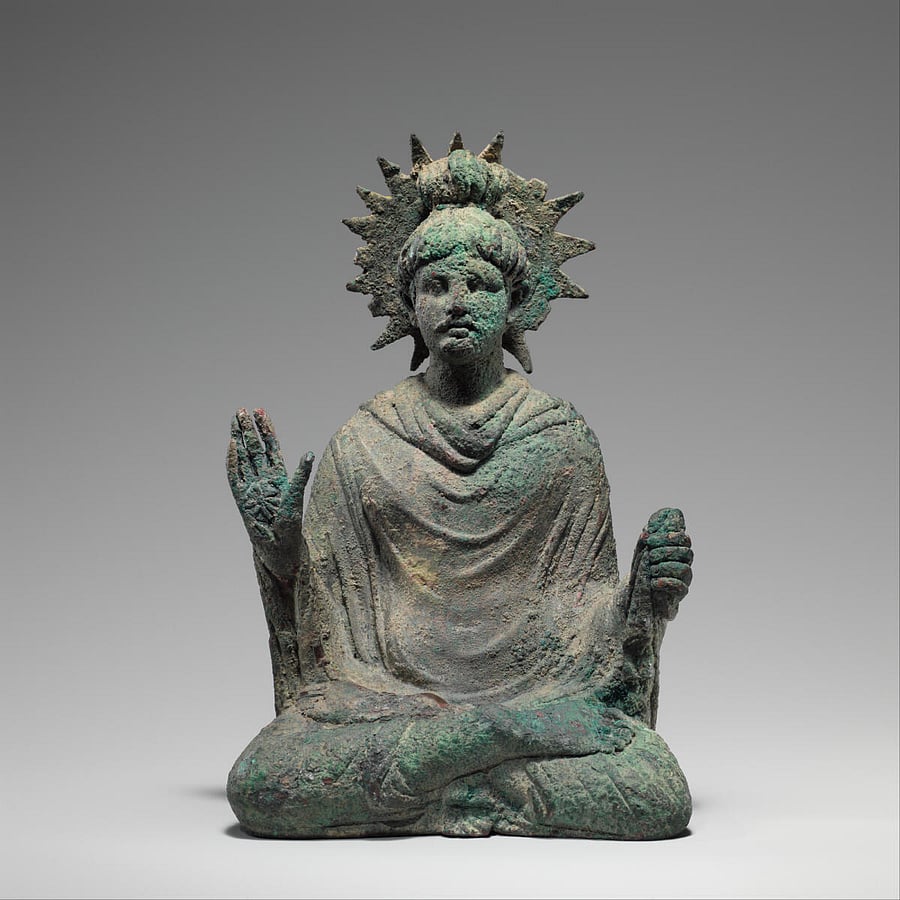
A first-century Gandharan sculpture of the Shakyamuni Buddha, a 10th-century Sri Lankan gilded statue of a standing Buddha and a 12th-century Tibetan Buddha Amoghasiddhi depicted on a cloth painting, all have one thing in common — the Buddha’s right hand is raised in what is known as the Abhaya Mudra, a gesture extending compassionate protection to the devotee.
Mudras, meaning ‘seals’ or ‘signs’ in Sanskrit, are a set of hand gestures and finger positions that serve as representational and symbolic devices in Buddhist art and practice. Entering the Buddhist visual lexicon around the third century CE, they serve primarily as a mode of expressing abstract concepts to the lay follower or practitioner.
One among the five commonly depicted mudras in Buddhism, the Abhaya Mudra is associated with the fifth Dhyani-Buddha Amoghasiddhi, one of the five transcendental Buddhas of the Mahayana Buddhist tradition. The word Abhaya directly translates to ‘fearlessness’, and the gesture dispels fear and denotes acts of pacification, reassurance or benevolence. Most scholars believe that this particular Mudra was used as a symbol of good intentions when approaching strangers, even before the onset of Buddhism. It is performed using either the right or both hands, with the fingers outstretched, with the palms slightly cupped and facing the viewer.
The Abhaya Mudra appears most significantly within Buddhist art — in murals, sculpture, thangkas and popular prints — where its context informs its particular symbolic meaning. Some esoteric sects in Tibet and Japan use Mudras in association with both the Buddha and the bodhisattvas whereas their use is more restrictive in the Theravada sects of Sri Lanka and Myanmar, where it is associated exclusively with the Buddha. When it is made with the left hand, as is common in Theravada Buddhism, it is thought to denote a warning or a command to halt. This interpretation is based on a popular Buddhist story in which the Buddha stopped the advances of a rampaging elephant released by a spiteful Devdutta — his nephew and disciple — by extending his hand in the Abhaya Mudra. In another incident, the Buddha uses the Mudra to resolve a water dispute within a family.
From Gandhara in present-day Pakistan to Thailand and Sri Lanka, even as the stylistic form of Mudra evolved and shifted, its symbolic function remains rooted in the same meaning: it signifies the subtle manifestations of the Buddha’s states of realisation. The fingers of the hand are thought to represent the five factors that constitute the physical phenomena (elements), experiences, types of awareness and levels of consciousness entailed in attaining Buddhahood so that the various gestural configurations helped realise a synthesis of these factors. Likewise, the positioning of the hands is also imbued with symbolic qualities — the right hand representing the male principle of agency, or samsara, and the left representing the female principle of wisdom, or nirvana. The constant changing of gestures and hand movements during liturgical practices expresses these deep meanings and is a step towards achieving the mental state of Buddhahood.
Discover Indian Art is a monthly column that delves into fascinating stories on art from across the sub-continent, curated by the editors of the MAP Academy. Find them on Instagram as @map_academy